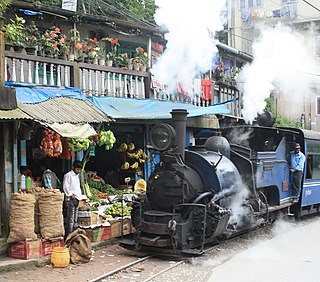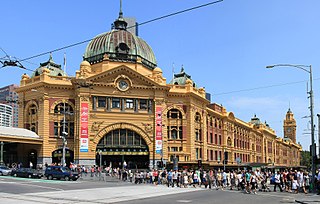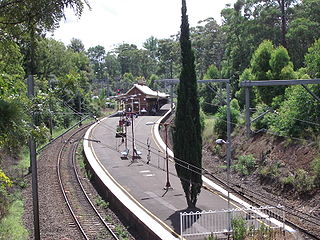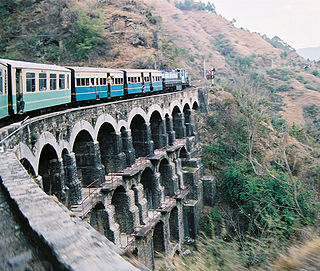
A heritage railway or heritage railroad is a railway operated as living history to re-create or preserve railway scenes of the past. Heritage railways are often old railway lines preserved in a state depicting a period in the history of rail transport.

Railway transportation is an important mode of the conveyance of people and goods in India. Indian Railways (IR) is the primary operator of rail operations throughout the country, a state-owned organisation of the Ministry of Railways, which historically had its own government budget. Between 2019 and 2020, 22.15 million passengers used the Indian Railways network daily. In the same period, 3.32 million metric tons of freight was also shipped daily on the IR network.

The S-train is a type of hybrid urban-suburban rail serving a metropolitan region. Some of the larger S-train systems provide service similar to rapid transit systems, while smaller ones often resemble commuter or even regional rail. They are especially common in Germany and Austria, where they are known as S-Bahn, which in the 1930s was an abbreviation of either Schnellbahn, Stadtbahn or Stadtschnellbahn, depending on the city, but they must not be confused with U-Stadtbahnen. Similar S-train systems exist also in Switzerland known as S-Bahn as well. In Denmark, they are known as S-tog[ˈesˌtsʰɔˀw], in the Czech Republic as Esko or S-lines, and northern Italy as Servizio ferroviario followed by either the word "metropolitano" or "suburbano".

The City Loop is a mostly-underground and partly surface-level subway and rail system in the central business district (CBD) of Melbourne, Victoria, Australia.

The Darjeeling Himalayan Railway, also known as the DHR or the Toy Train, is a 2 ft gauge railway that runs between New Jalpaiguri and Darjeeling in the Indian state of West Bengal. Built between 1879 and 1881, it is about 88 km (55 mi) long. It climbs from about 100 m (328 ft) above sea level at New Jalpaiguri to about 2,200 m (7,218 ft) at Darjeeling, using six zig zags and five loops to gain altitude. Six diesel locomotives handle most of the scheduled service, with daily tourist trains from Darjeeling to Ghum – India's highest railway station – and the steam-hauled Red Panda service from Darjeeling to Kurseong. Steam-enthusiast specials are hauled by vintage British-built B-Class steam locomotives. The railway's headquarters are at Kurseong.

The Melbourne rail network is a passenger and freight train system in the city of Melbourne, Victoria, Australia. It is the core of the larger Victorian railway network, with links to both intrastate and interstate systems. A large suburban passenger network centred on the CBD also operates, with a limited degree of segregation from longer-distance passenger and freight trains.
Railroad directions are used to describe train directions on rail systems. The terms used may be derived from such sources as compass directions, altitude directions, or other directions. However, the railroad directions frequently vary from the actual directions, so that, for example, a "northbound" train may really be headed west over some segments of its trip, or a train going "down" may actually be increasing its elevation. Railroad directions are often specific to system, country, or region.

Gauntlet track or interlaced track is an arrangement in which railway tracks run parallel on a single track bed and are interlaced such that only one pair of rails may be used at a time. Since this requires only slightly more width than a single track, all rails can be carried on the same crossties/sleepers. Trains run on the discrete pair of rails appropriate to their direction, track gauge or loading gauge.

The Budapest Metro is the rapid transit system in the Hungarian capital Budapest. It is the oldest electrified underground railway system in continental Europe, and is only pre-dated by the London Underground. Budapest's iconic Line 1 was completed in 1896.

A double-track railway usually involves running one track in each direction, compared to a single-track railway where trains in both directions share the same track.

An island platform is a station layout arrangement where a single platform is positioned between two tracks within a railway station, tram stop or transitway interchange. Island platforms are popular on twin-track routes due to pragmatic and cost-effective reasons. They are also useful within larger stations where local and express services for the same direction of travel can be provided from opposite sides of the same platform thereby simplifying transfers between the two tracks. An alternative arrangement is to position side platforms on either side of the tracks. The historical use of island platforms depends greatly upon the location. In the United Kingdom the use of island platforms is relatively common when the railway line is in a cutting or raised on an embankment, as this makes it easier to provide access to the platform without walking across the tracks.

Automatic train operation (ATO) is an operational safety enhancement device used to help automate the operation of trains. The degree of automation is indicated by the Grade of Automation (GoA), up to GoA level 4. ATO is primarily used on automated guideway transit and rapid transit systems where it is easier to ensure the safety of humans. On most systems, there is a driver present to mitigate risks associated with failures or emergencies.

The Société de transport de Montréal is a public transport agency that operates transit bus and rapid transit services in Montreal, Quebec, Canada. Established in 1861 as the "Montreal City Passenger Railway Company", it has grown to comprise four subway lines with a total of 68 stations, as well as over 186 bus routes and 23 night routes. The STM was created in 2002 to replace the Société de transport de la communauté urbaine de Montréal (STCUM). The STM operates the most heavily used urban mass transit system in Canada, and one of the most heavily used rapid transit systems in North America. As of 2011, the average daily ridership is 2,524,500 passengers: 1,403,700 by bus, 1,111,700 by rapid transit and 9,200 by paratransit service.

The Bankstown Line is a commuter rail line operated by Sydney Trains in Sydney, New South Wales, Australia. It serves Canterbury-Bankstown and parts of the Inner West and Western Sydney. The Bankstown railway line is the physical railway line which carries the section of the Bankstown Line between Sydenham and Birrong.

The Mountain railways of India are the narrow-gauge railway lines that were built in the mountains of India.

The Kalka–Shimla railway is a 2 ft 6 in narrow-gauge railway in North India which traverses a mostly mountainous route from Kalka to Shimla. It is known for dramatic views of the hills and surrounding villages. The railway was built under the direction of Herbert Septimus Harington between 1898 and 1903 to connect Shimla, the summer capital of India during the British Raj, with the rest of the Indian rail system.

Sydney, the largest city in Australia, has an extensive network of passenger and freight railways. The passenger system includes an extensive suburban railway network, operated by Sydney Trains, a metro network and a light rail network. A dedicated freight network also exists. Future expansion of the light rail network includes the Parramatta Light Rail. Existing light rail services are the Inner West Light Rail and the CBD & South East Light Rail.
SelTrac is a digital railway signalling technology used to automatically control the movements of rail vehicles. It was the first fully automatic moving-block signalling system to be commercially implemented.

Urban rail transit in India plays an important role in intracity transportation in the major cities which are highly populated. It consists of rapid transit, suburban rail, monorail and tram systems. According to a report published in 2021, a total of 2,636 million people travel annually in metro systems across India's thirteen major cities, placing the country as one of the busiest urban rapid transit hub in the world in terms of ridership. The combined length of 741.7 kilometres of metro systems in India makes it the fifth longest in the world with in operation.

The Bankstown railway line is a railway line serving the Canterbury-Bankstown and Inner West regions of Sydney between the stations of Sydenham and Lidcombe.


















